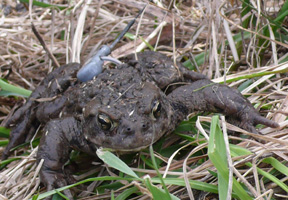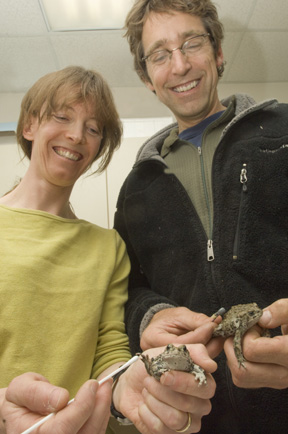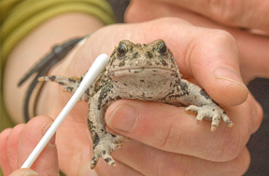ISU researchers seek clues to why Wyoming toads are disease resistant
June 26, 2008
To croak or not to croak, both literally and figuratively, is the question.
Boreal toad populations have declined severely in Colorado, but not in western Wyoming or Montana. Idaho State University researchers are trying to help determine why this is happening. They’re tracking these nocturnal animals by using tiny radiotransmitters attached to the amphibians, to record their movement, temperature and habitat use.
 Researchers are resorting to these methods because die-offs of the southern populations of the boreal toad (Bufo boreas boreas), including those from southeast Wyoming, Colorado and New Mexico, have been so severe that they were considered a candidate for listing under the U.S. Endangered Species Act (ESA).
Researchers are resorting to these methods because die-offs of the southern populations of the boreal toad (Bufo boreas boreas), including those from southeast Wyoming, Colorado and New Mexico, have been so severe that they were considered a candidate for listing under the U.S. Endangered Species Act (ESA).
The toad has not been observed in New Mexico since 1986, with severe declines between the late 1970s to early 1980s according to Peter Murphy, Ph.D., Idaho State University visiting biology professor. Although the southern populations of the toad were not considered sufficiently distinct from the northern, and so declined ESA listing in 2005, they are listed as a “state endangered” by the Colorado Division of Wildlife.
The die-offs of the southern boreal toads appear to have been caused by a fungal skin disease, the same disease that has caused die-offs of amphibians worldwide. ISU researchers are working under a grant from the United States Geological Survey and National Park Service with colleagues from these agencies and the Colorado Division of Wildlife, to help understand this problem.
ISU researchers involved in the projects are Murphy and fellow biological sciences professors Sophie St.-Hilaire, Ph.D., DVM, and Charles Peterson, Ph.D.
“Although the appearance of the chytrid fungus is linked to deaths of the toads in Colorado and amphibians worldwide, how this fungus causes death is not known,” Murphy said. “We know that in Grand Teton boreal toads, more than 50 percent carry the pathogen (the fungus), but there are no recent die-offs.”
Why Colorado toads, but not those from northwestern Wyoming, are declining from this fungal disease, is the central question of the current field and lab work according to Murphy.
Researchers are trying to determine if the toads in Wyoming are just more resistant to the disease associated with the presence of the fungus, or if there are environmental factors that explain why toads from one region are susceptible and those from the other are not. The ISU researchers are examining the problem from two angles, from field sites in Wyoming and Colorado, and in laboratory experiments at Idaho State University's main campus in Pocatello.
Murphy and two field assistants are doing much of the fieldwork and St-Hilaire is doing much of the laboratory work, but all the researchers help out one another in both areas. Tracking toads in the field isn't easy in the high-mountain wilds of Wyoming and Colorado, which include sites in and near Grand Teton National Park and in the Bears Ears Mountains of Colorado near Steamboat Springs. Toads are more active and easier to see at night, so ISU researchers have to be, too, at a time when other animals are active, including large mammals.
 “We’re out there at night, being quiet and still, which can lead to interesting meetings with other animals,” Murphy said. “I've startled both moose and bison doing the research.”
“We’re out there at night, being quiet and still, which can lead to interesting meetings with other animals,” Murphy said. “I've startled both moose and bison doing the research.”
This is also grizzly bear country, but so far Murphy and St-Hilaire haven't run into any during their night-time forays. The tiny radiotransmitters, attached with surgical tubing and fishing leader around each toad’s waist, enable Murphy to track the movement, location and body temperature of nearly 40 toads, in addition to nearby air temperature, humidity and vegetation type.
All of these factors may affect the growth of the skin pathogen. Of course, first they have to catch the toads, attach the tiny transmitters, and then release the toads back into the wild – and big game biologist think tracking a wolf or deer outfitted with a radiocollar is difficult.
“I am looking for factors in the environment that may be protecting the toads,” Murphy said. “In particular, toads may protect themselves by achieving high body temperatures behaviorally.”
It may be that maintaining temperatures in excess of 30 degrees centigrade (about 86 degrees Fahrenheit) for sufficient time slows the growth of the fungus, enabling a toad to combat the disease. Also, bacteria in amphibian skin have been shown to inhibit the chytrid fungus, and such bacteria may differ in the skin of Wyoming and Colorado toads.
Among several hypotheses, the ISU researchers suggest that because the habitat of toads is at higher elevation in Colorado than in Wyoming, there is a smaller window of opportunity each day in Colorado for toads to achieve high body temperatures and knock back the growth of the fungus, so it may achieve lethal levels more often. In current lab experiments, St-Hilaire and Murphy are manipulating temperature, humidity and pathogen exposure in captive-reared Colorado toads and examining which combination of conditions produces severe disease. They are also testing whether any of more than 20 strains of bacteria isolated from toad skin may inhibit the growth of the chytrid fungus.
Both Murphy and St-Hilaire emphasized that their research efforts now are fairly open ended, but the results could have important implications not just for the boreal toad in the Southern and Northern Rockies, but for other species of amphibians being decimated by the chytrid fungus.
Categories:
